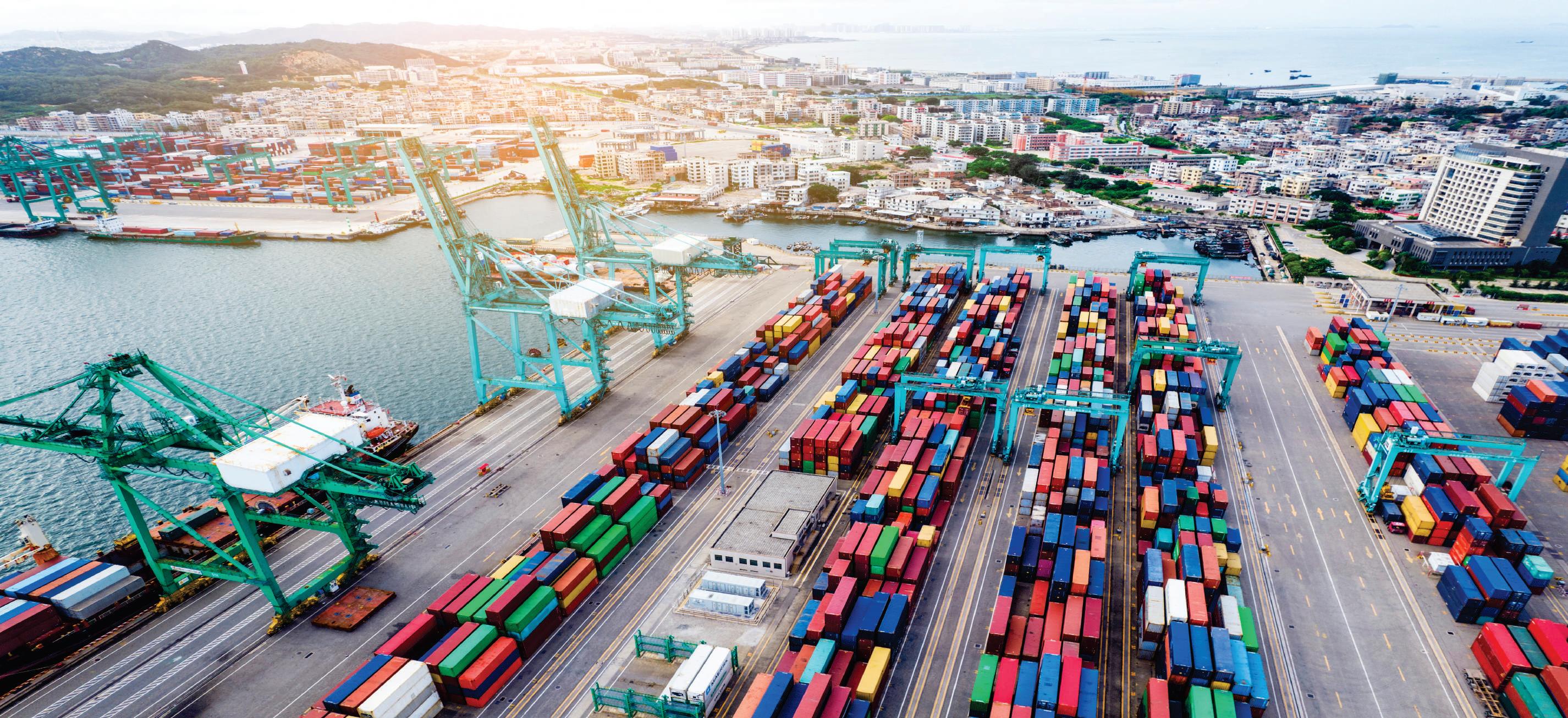
7 minute read
OVERVIEW
[ 96 ] | OVERVIEW
INDIA’S PETROCHEMICAL INDUSTRY SET TO CHART A NEW GROWTH TRAJECTORY
Advertisement
Backed by big ticket investments into infrastructure development, the industry is setting the stage for a longterm fruitful journey ahead
India's petrochemical industry is poised for a sweeping transformation through 2030. The change is propelled by a significant expansion of its intermediates’ production capacity, and growing focus on reducing the sector's carbon and environmental footprint by both industry as well ad policy makers. With its high demand growth, India is projected to contribute to more than 10 percent of the incremental global growth in petrochemicals over the next decade.
Given its significant import dependence, India could potentially need more than 15 world-scale petrochemicals assets by 2035 to meet domestic demand. Presently, there are eleven naphtha or dual feed cracker complexes in operation with combined ethylene capacity of about 7.05 million tonnes per annum. In addition, there are six aromatic complexes in operation with a combined Xylene capacity of about 5.5 million tonnes. Demand for plastics in India is expected to reach 24 million tonnes by 2022-23 and 35 million tonnes by 2027-28. The Indian market is seeing a surge in petrochemical capacities from domestic companies that have traditionally dominated the market such as Reliance and Indian Oil Corporation Limited (IOCL) which currently account for almost 70% of production. With slowing growth and diminishing margins in the core oil and gas business, petrochemicals are a logical extension for these players. While Reliance and IOCL have expanded their petrochemicals production in the past couple of years, HPCL-Mittal Energy Limited (HMEL) is expected to quadruple its petrochemicals capacity over the next couple of years.
New domestic players such as ONGC Petro additions Limited (OPaL) and Deepak Phenolics are recent entrants in the petrochemical space. In the next three to five years, HPCL Rajasthan Refinery Limited (HRRL) and Bharat Petroleum Corporation Limited (BPCL) will join the list with their refinery-integrated petrochemicals assets. Over the past three years, global firms such as Saudi Aramco, Rosneft (Nayara), BASF, and Borealis have announced plans to invest in Indian petrochemicals manufacturing. Importantly, the mammoth 18 million metric ton (MMT) West Coast refinery is being planned as a joint venture between the Abu Dhabi National Oil Company (ADNOC), Saudi Aramco, IOCL, BPCL, and HPCL. This venture could significantly alter the face of the Indian petrochemicals landscape.
CHANGE IS INEVITABLE
As petrochemical production displaces transport fuels as the main consumer of crude oil, refinery assets will be converted into chemical and petrochemical hubs. With petrochemicals now accounting for 40 to 80 percent of new refining assets, the evolution of new crude-to-chemicals technologies is accelerating the shift of oil and gas majors away from refining. India’s petrochemical capacity is projected to grow by more than 30 percent in the 2017–2025 period. The number of domestic refineries with linked petrochemical capacity is expected to grow from 12 (out of 22) in 2010 to 19 (out of 24) in 2030. In addition, new refinery expansion projects and greenfield refineries are being built with an integrated petrochemical configuration, with HRRL, HMEL, and the West Coast refinery being notable examples in this category.
Given the strong underlying demand trends, the sector is now witnessing a significant investment boom, with several multibillion-dollar assets either already on stream or expected within the next few years. Projects like HMEL in Bhatinda and HPCL in Barmer are expected to be completed by 2021-22 and 2022-23, respectively.
Nayara's mega petrochemical project in Vadinar is expected to be completed by 2024-25. And several other projects are likely to be commissioned beyond that. These investments, which include public and private projects in various stages of implementation and pipeline, will make petrochemicals the biggest driver of India's crude oil demand growth.
India’s petrochemical players have mostly evolved their portfolios from legacy refinery setups to drive higher net realization. As a result, the focus has been on basic commodity chemicals where technology licenses have been readily available. Capacity expansions are expected for polyethylene (PE), polypropylene (PP), polyethylene terephthalate (PET), and polyvinyl chloride (PVC), monoethylene glycol, elastomers and styrene, among others.
Historically, given India’s net surplus and limited gas production, naphtha has been the dominant feedstock for Indian producers. The large proportion of India’s petrochemicals capacity continues to be refinery integrated due to limited feedstock availability. The massive push towards circular economy, driven by fast changing consumer preferences and regulators, has made petrochemical producers focus substantially on embedding sustainable practices across their business. Players can reduce conversion costs by 5 to
OVERVIEW | [ 97 ]
10 percent by embracing digital operations including digitalization of equipment data combined with analytics.
TRENDS SHAPING THE LANDSCAPE
The enhanced pace of partnership and mergers and acquisitions (M&A) opportunities in the Indian petrochemicals market can potentially shift the dynamics of competition in the industry, with India emerging as the next horizon for global giants to unlock a new frontier for growth. Global oil and gas and chemical giants are targeting big-ticket investments in established domestic companies to mark their entry into India. As an example, Saudi Aramco recently signed a memorandum of understanding to evaluate up to a 20 percent equity stake in Reliance’s oil-to-chemicals business, valued at around $15 billion.
Strategic partnerships are emerging between global and domestic players, creating a win-win situation for both. Recently Russian petrochemicals company, Sibur formed a joint venture with Reliance for production of butyl rubbers. Similarly, Adani, Borealis, BASF, and ADNOC are evaluating a joint venture for a propane dehydrogenation (PDH) plant for acrylates, oxo alcohols, and PP production. In addition, Indian public sector undertakings (PSUs), Saudi Aramco, and ADNOC are evaluating setting up a West Coast refinery and petrochemicals complex with a total investment of $45 billion and petrochemicals capacity of 18 MMT. Finally, global players are also targeting niche manufacturers to diversify downstream. For example, DSM India acquired SRF Limited’s engineering plastics business.
Existing players and new entrants are analyzing and responding to the product-level demand–supply scenarios. For example, BPCL is entering the propylene oxide (PO) chain with a petrochemicals expansion in its Kochi refinery. The joint venture between BASF, Adani, ADNOC, and Borealis is targeting the deficit in acrylics and oxo alcohols within the propylene chain. However, overall, there is still significant room for new or incumbent players to invest in other petrochemicals derivatives such as glycols, polyurethanes, and rubbers.
Reliance has installed an off-gas cracker complex of about 1.5 MMT with the capability to use both propane and ethane as feedstock. The company has invested in setting up an end-to-end supply chain for importing and storing ethane from the US. Additionally, greenfield petrochemicals units in India are increasingly adopting mixed feed in their assets.
OPaL has flexibility in its cracker configuration to process a wide basket of feedstocks such as naphtha, ethane, and propane. HPCL’s HRRL project will also include a dual-feed steam cracker unit for its petrochemical production.
WAY FORWARD
The coming decade in India’s petrochemicals market is likely to be characterized by substantial opportunities and significant disruptions. Investing in the right molecular chains and evolving a robust product portfolio will differentiate players in the long term. Niche petrochemicals and specialty players that depend on large petrochemical facilities for feedstock need to reevaluate availability of intermediates and building blocks amid rising domestic petrochemical capacities.
This would allow them to identify opportunities for upstream integration or expansion of their portfolio offerings.
Petrochemical players will need to carefully assess market dynamics, capability requirements, business model fit, the competition landscape, and potential disruptions before making strategic long-term bets. The players focusing on commodity products will need to identify downstream derivatives for their next wave of growth, while ensuring healthy returns and synergies from their existing asset base.
New entrants can enter one of the white spaces in downstream petrochemicals products or expand into competitive segments with a better value proposition. For example, new players can enter into C4 and aromatics chains, which have abundant feedstock supply but limited downstream derivatives production; for example, polycarbonates, linear alkyl benzene, and butyl rubber.
The petrochemicals sector is projected to emerge as the primary driver of growth for the global oil and gas sector, accounting for more than a third of incremental oil and gas demand by 2030. To enable transformation, the petrochemicals landscape needs to overcome uncertainties such as trade restrictions, and growing environmental headwinds emerging from the circular economy mega trend and rising bans on single-use plastics. In the longer run, the operational excellence and cost competitiveness are likely to emerge as significant drivers of success for Indian petrochemical players. n











